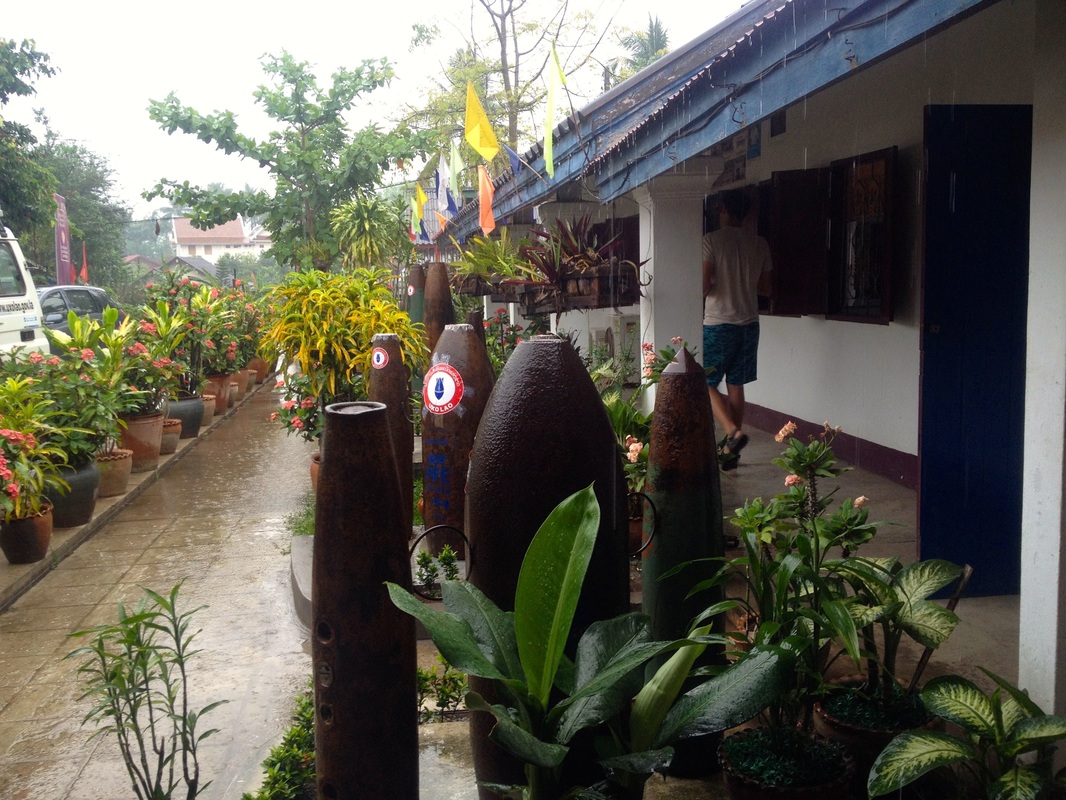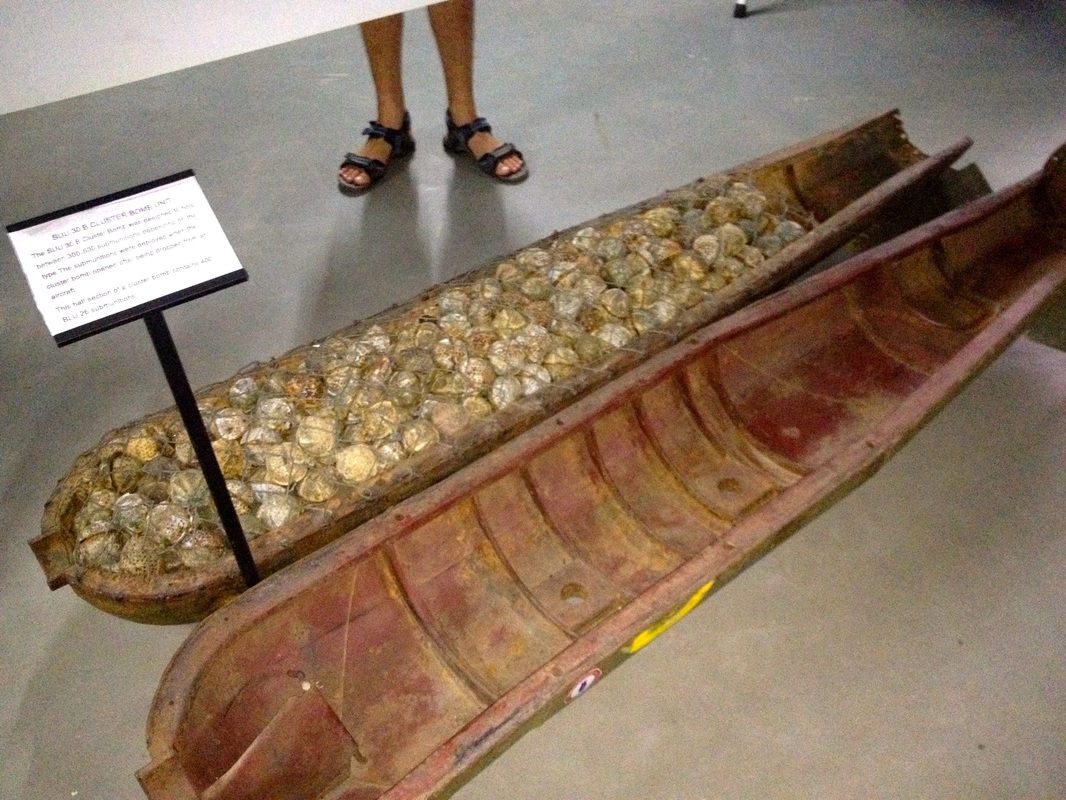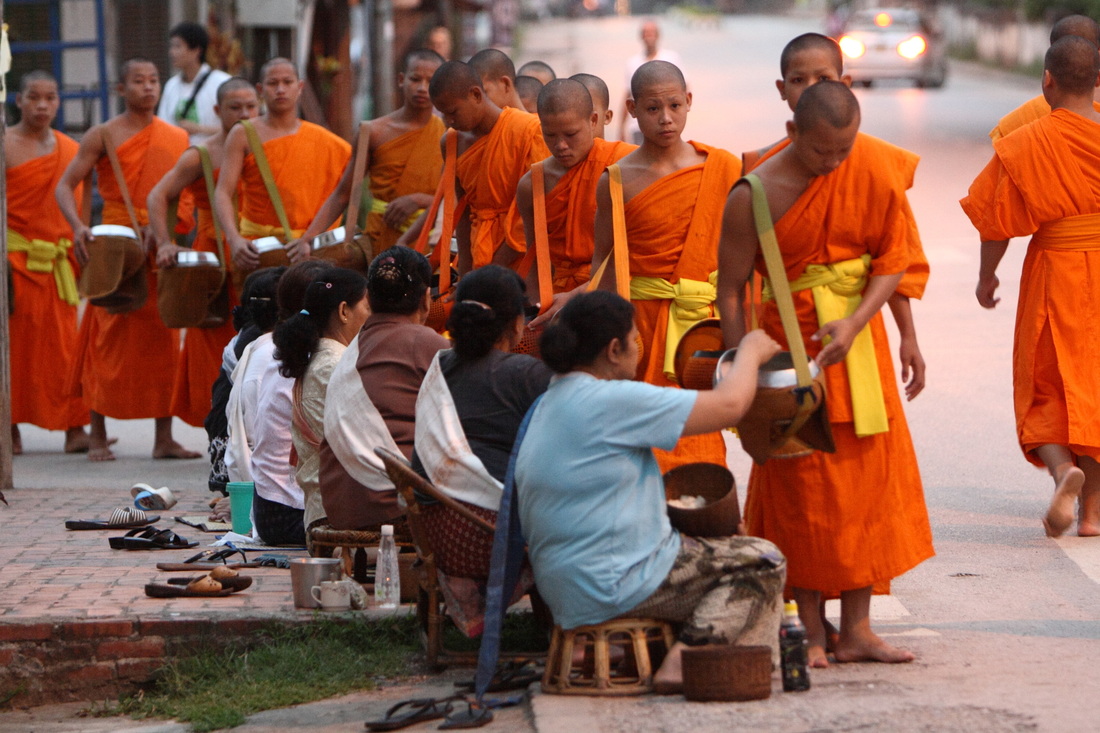And so we entered Laos with bated breath, not quite sure what to expect. Luckily Luang Prabang is a haven for the weary SE Asia traveller. A beautiful, peaceful town, with many Buddhist wats glinting gold in the sun, a couple of wine bars (for those who have been craving), and lovely food. Wandering the backstreets is a lovely experience and we took plenty of opportunities to do so.
Of course we arrived the night of the 60th anniversary of the communist revolution in Laos. There were stage shows, festivities, Karaoke all night long in the restaurant over the road from our room. At one point we saw line dancing from our window. Even earplugs did not stop the noise – the singers were in my room i swear!
Laos is a tiny country nestled between Vietnam, Cambodia and China. Often overlooked by everyone, especially during the Vietnam war. Whilst Vietnam and the USA had a strict set of rules about bombing and destruction, here was no such agreement with Laos. So the war fought here was bloody destructive and secret. For years he us govt denied it had been fought and even today there are still millions of bombies scattered over the Laos countryside, making farming and living out here a difficult and life threatening occupation.
The UXO museum was small but powerful. 300 people are killed each year by UXOs and more injured, while this isn’t a large number the cost to families is they lose a member or their main source of income which can be devastating. Whilst they have teams still disarming bombies they also have a side arm teaching families and children about what UXOs are, why you don’t play with them, and how you can avoid getting hurt. It was so sad watching a video about kids who’d inadvertently played with them and then got maimed. They showed us how teams from countries like Germany, Australia and the UK had helped set up and fund the organization to teach, find and dearm UXOs.
 Regions in Laos that were bombed are highlighted in red and yellow.
Regions in Laos that were bombed are highlighted in red and yellow.
Here are some other startling facts about the U.S. bombing of Laos and its tragic aftermath:
- Over 270 million cluster bombs were dropped on Laos during the Vietnam War (210 million more bombs than were dropped on Iraq in 1991, 1998 and 2006 combined); up to 80 million did not detonate.
- Nearly 40 years on, less than 1% of these munitions have been destroyed.More than half of all confirmed cluster munitions casualties in the world have occurred in Laos.
- Each year there continue to be over 100 new casualties in Laos. Close to 60% of the accidents result in death, and 40% of the victims are children.
- Between 1995 and 2013, the U.S. contributed on average $3.2M per year for UXO clearance in Laos; the U.S. spent $13.3M per day (in 2013 dollars) for nine years bombing Laos.
- The U.S. spent as much in three days bombing Laos ($51M, in 2010 dollars) than was spent for clean up over 16 years ($51M).
Thanks to http://legaciesofwar.org/about-laos/secret-war-laos/ for these

Bombies outside the UXO museum
|

Inside are tiny bombies…
|
Yum Yum!
The food in Laos is quite different, they favour spicy chili, Thick broth soup noodles called khao piak for breakfast, sticky rice, rough coffee with the obligatory sweetened condensed milk. Our favorite dining experience was at
Khaiphaen a NGO restaurant that supports young people from the country to learn how to speak English, train in the restaurant and then get a job afterwards. It’s a fantastic way to eat,
and give back to the local community. The food was fantastic.
There are also brilliant night food markets, where you can spend 15,000 kip ($2) for a bowl that you fill up with at a vegetarian buffet. For another 15,000 kip you can get a piece of meat they will grill. Huge whole fish, quail, or half a chicken.
My favorite lao dish: Sticky rice with mango!
My favorite drink: Cinnamon iced coffee and coconut ice-cream!
Wonderful Wats
 early morning offerings
early morning offerings
The Buddhist temples are beautiful. Gilded in gold and precious stones, they are stunning in the sunlight, while yellow robed monks wander around making the whole town feel like a Buddhist retreat.
At 5am I made Greg get up to go and watch the monks alms procession through the streets. Whilst I wanted to respect the ceremony somehow I was conned into giving alms and bought some food from one of the many sellers. Luckily I sat next to a Laotian lady who spoke english who shared her thoughts on Buddhism and knowledge on how to give alms. There are rules although sadly many tourists seem to ignore them and I saw some pretty horrid things like tourists putting their camera into the monks faces etc. As we were very cautious to be respectful we left the cameras at home. Below is a pic from Wikipedia to give you a sense of the procession.
The actual alms giving was really lovely, less processional and more practical, the monks walked by very fast, and we had to scramble to place food in their pots.
She told me how she does this every morning in Vientiane and was visiting to see her sister and the famous wats here.

From wikipedia
At night…
 Our musician – the instrument can imitate all sorts of sounds.
Our musician – the instrument can imitate all sorts of sounds.
We saw the wonderful arts and crafts museum and learnt about the various different ethnic groups in Laos. Very interesting, they showed how to weave and dye cloth and mentioned how they set up the huge night markets to help country people make a living selling handicrafts, (despite all looking the same! ). One night we stumbled across a storytelling theatre show, it was fantastic with ethnic instrument being played by a wizened old man and his younger companion telling us myths about Luang Prabang.
Waterfalls, bears and butterflies!
Off to Kuang Si Waterfalls! The journey is an adventure where you and a driver try to fill up a bus, took us about about 45min to fill the bus enough but we got there. Then off on hour 1 hr journey. On the way to the falls there is a park called
Free the Bears, they rescue black bears them from tiny cages where they farm bear bile for the Chinese medicine market. These bears are adorably playful and content to roam around their forest enclosure. Do read more and donate
here.
True to its name sake, Kuang Si is peaceful, and gorgeous despite the hoards of visitors. The calcium rich water taking on an aqua hue. We clambered to get to the top pools half way up steep falls. Swum in the cool water and it was heavenly. Monks tourists and locals all bathing together.
After the refreshing swim we wandered by a butterfly park. Created by a Dutch couple , they managed to create a beautiful set of gardens ideal for breeding and attracting butterflies. I had a natural fish spa, where the fish are free roaming in the water from Kuang Si falls, saw beautiful orchids, and some strange and foreign plants, like cacti, which have come from Laotian family gardens. An interesting note is there are no garden centres here, so if you like a plant you see in someone’s yard, you just go up and ask them how much for a cutting!
Caves and upriver on the Mekong
Took a boat to the Pak Ou Caves, for a very relaxing trip up the Mekong river. Saw elephants, buffalo, fishermen and dirty children taking baths. Lots of locals waved at us.We were taken to Whiskey village and sampled brown sticky rice wine, and the Laotian firewater, also known as LaoLao. I liked the rice wine, sweet red and spicy – Greg thought it was hideous. The whiskey/firewater is a whopping 50% alcohol – ouch!We made it to the caves despite trying to kill our livers and they were beautiful. A serene, reverent atmosphere full of buddhas from devotees going back hundreds of years. Interestingly it was first discovered by the French explorers in the 1800’s, I can only imagine what it would have looked like then for these men who spoke no Lao and were venturing far beyond the borders of their ‘civilised world’.
Up next is a big adventure where we trekked out to the world’s largest cave that crosses the Lao/Vietnam border.
Will Jade and Greg get to the right village and in one piece?
Will they make it out alive?
Or do they fall prey to the evil cave bats and get eaten by the river monster?!
Find out in the next installment of Leaving Fingerprints!
 Regions in Laos that were bombed are highlighted in red and yellow.
Regions in Laos that were bombed are highlighted in red and yellow.  Our musician – the instrument can imitate all sorts of sounds.
Our musician – the instrument can imitate all sorts of sounds.